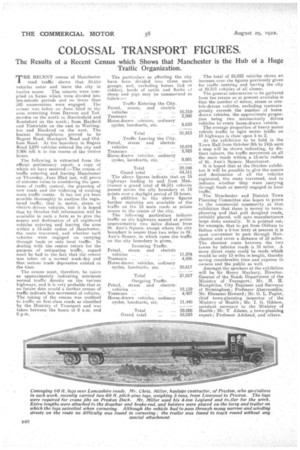COLOSSAL TRANSPORT FIGURES.
Page 24

If you've noticed an error in this article please click here to report it so we can fix it.
The Results of a Recent Census which Shows that Manchester is the Hub of a Huge Traffic Organization.
THE RECENT census of Manchester road traffic shows that 55,(.123 vehicles enter and leave the city in twelve hours. The returns were compiled on forms which were divided into ten-minute periods and 110 fewer than 540 enumerators were engaged. The tenses was taken_ on June 22nd in the area stretching from Darwen and Todmerden on the north to Macclesfield and Enutsford on the south ; from Hayfield and Tintwistle on the east to Warringten and 131ack.rod on the west. The busiest thoroughfares proved to be Regent Road, Stockport Road and Oldham Road. At the boundary in Regent Road 3,074 vehicles entered the city and 2,986 left it in the Couese of the twelve hours.
The following is extracted from the official preliminary report, a copy of _which we have received :—The census of traffic entering and leaving Manchester on Thursday, June 22nd last, will prove .of extreme value in considering the (pies_ tions of traffic control, the planning of new roads and the widening of existing main traffic routes. It. has not yet been possible thoroughly to analyse the registered traffic, thaa is, motor, steam or electric-driven vehicles, but it. is hoped that by October full information will be available in such a form as to give the source and destination of all registered vehicles entering and leaving the area within a 15-mile radius of Manchester, the route traversed, and whether such vehicles were engaged on carrying through loads or only local traffic. In dealing with -the census return for the purpose of estimating traffic, regard must be had to the fact that the Census was taken on a normal week-day and That serious trade depression existed at the time.
The census must, therefore, be taken as approximately .indicating minimum normal traffic density on the various highways, and it is very probable that at no future date would a further census of traffic indicate less movement of vehicles. The taking of the census was confined to traffic on first-class roads as classified by the Ministry of Transport and was taken between the hours of B a.m. and 8 p.m. The particalars as affecting the city have been divided into three main groups, and, excluding horses (led, or ridden), herds of cattle and flocks ef sheep. and pigs may be summarized as follow:— Traffic. Entering the City. Petrol, steam, and electric vehicles . . 10,310 Tramcars ... 2,980 Horse-drawn vehicles, ordinary Ludes, handcarts, etc. 8,623 Total ... 21,913 -Traffic Leaving the City. Petrol, steam and electric vehicles ... .,. 10,674 Tramcars ... 2,923 Horse-drawn vehicles, ordinary cycles, handcarts, etc. ... 9,001.
— Total ... • ... 22,598 Grand total . 44,511 The above figures indicate that on 15 highways leading to and from Manchester a grand total of 44,511 vehicles passed across the city boundary at 15 points over a daylight period of 12 hours.
In addition to the above figures further statistics are available of the traffic on the 15. main roads at points nearer to the centre of the city.
The following particulars indicate traffic on the highways named at points approximately two miles distant from St. Ann's Square, except where the city boundary is nearer than two miles to St. Ann's Square, in which cases the traffic on the city boundary is given.
Incoming Traffic. Petrol, steam and electric .
vehicles ... ... 11,974
Tramcars ... ... 4,426
Horse-drawn vehicles, ordinary cycles, handcarts, etc. 10,617 Total 27,017
Outgoing Traffic. Petrol, steam and electric, vehicles
Tramcars Horse-drawn vehicles, ordinary cycles, handcarts, etc. 12,159' 4,407 11,440 Total . Grand total 28,006 55,023 The total of 55,023 vehicles shows an increase over the tigures previously given for traffic entering and leaving the city of 10,512 vehicles of all classes. The general information to he gathered from the return as at present available is that the number of motor, steam or electric-driven vehicles, excluding tramcars greatly exceeds the number of horse drawn vehicles, the approximate proportion being two mechanically driven vehicles to' every horse-drawn vehicle.
The average proportion of heavy motor vehicle traffic to light motor traffic on 15 highways is close upon 5 to 2. -At the exhibition to he held in the Town Hall from October 9th to 14th next map will be shown indicating, by distinct colours, the traffic movement on all the main roads within a 15-mile radius of St. Ann's Square, Manchester, It is hoped that at the October exhibiton it will be possible to give the source and destination of all the vehicles registered, the route traversed, and to indicate whether they were carrying through loads or merely engaged in local traffic.
The Manchester and District Town Planning Committee also hopes to prove to the comities...jai community at that exhibition that there is money in townplanning and' that well designed roads, suitably placed, will save manufacturers large sums annually. It is pointed out, for example, that to get from Oldham to Bolton with a 5-ton lorry at present it is must convenient to pass through Manchester and cover a distance of 18 miles, The shortest route between the two towns by inferior roads is 16 miles. A more direct route could be made which would be only 13 miles in length, thereby saving considerable time and expense to owners and the public as well.
Amongst the speakers at. the exhibition will be Sir Henry ftlaybury, DirectorGeneral of the Roads Department of the Ministry of Transport ; Aft-. .H. H. Humphries, City Engineer and Surveyor of Birmingham; Professor Abercrombie, Mr. Ebenezer Howard; Mr. G. L. Pepler, chief town-planning inspector of the Ministry of Health ; Mr. I. G. Gibbon, assistant secretary to the Ministry of Health ; Mr. T. Adams, a town-planning expert ; Professor Adshead, and others.




























